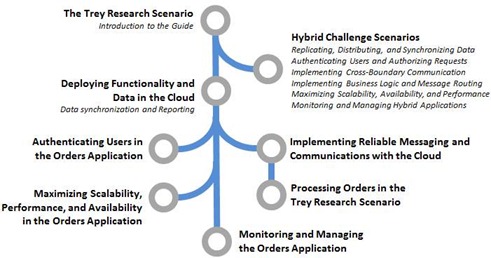Microsoft Patterns & Practices-Building Hybrid Applications in the Cloud on Windows Azure
This guide focuses on the common issues you will encounter when building applications that run partly in the cloud and partly on-premises, or when you decide to migrate some or all elements of an existing on-premises application to the cloud. It focuses on using Windows Azure as the host environment, and shows how you can take advantage of the many features of this platform, together with SQL Azure, to simplify and speed the development of these kinds of applications. Windows Azure provides a set of infrastructure services that can help you to build hybrid applications. These services, such as Service Bus Security, Messaging, Caching, Traffic Manager, and Azure Connect, are the main topics of this guide. The guide demonstrates scenarios where these services are useful, and shows how you can apply them in your own applications. This guide is based on the experiences of a fictitious corporation named Trey Research who evolved their existing on-premises application to take advantage of Windows Azure. The guide does not cover the individual migration tasks, but instead focuses on the way that Trey Research utilizes the services exposed by Windows Azure and SQL Azure to manage interoperability, process control, performance, management, data synchronization, and security. |
||||||
What’s in “Building Hybrid Applications in the Cloud” ? |
||||||
Click here to download this release. |
||||||
Goals of This Release |
||||||
This book gives you enough information to build hybrid solutions when you're planning a new application or making changes to an existing one. It is intended for any architect, developer, or information technology (IT) professional who designs, builds, or operates hybrid applications that need to integrate cloud and on-premises. In addition to the previous 2 guides, this book contains the latest Windows Azure services such as Service Bus, Caching, Azure Connect, and Traffic Manager. It also contains some of the latest SQL Azure features such as Data Sync. This book shows you when and how to use these services in the context of some commonly occurring hybrid scenarios. |
||||||
Acknowledgements |
||||||
Many people contributed to this release, but we wanted to highlight the contributions of the following subject matter experts: Clemens Vasters, Mark Scurrell, Jason Chen, Tina Stewart, Arun Rajappa, and Corey Sanders. We also want to thank Kashif Alam, Vijaya Alaparthi and Enrique Saggese for their support throughout. |
||||||
Customer Connections |
||||||
We are happy to engage in customer conversations as appropriate. Please contact Masashi Narumoto or Eugenio Pace. If you have a customer using Building Hybrid Applications in the Cloud, please let us know at ourstory@microsoft.com. |
||||||
About patterns & practices |
||||||
The Microsoft patterns & practices (p&p) team is responsible for delivering applied engineering guidance that helps software architects, developers, and their teams take full advantage of Microsoft’s platform technologies in their custom application development efforts. Our goal is to help software development teams be more successful with the Microsoft application platform. We do this by delivering guidance that: · Helps to simplify the Microsoft application platform. · Provides solution guidance to common problems. · Helps development teams grow their skills and learn. For more information: https://msdn.microsoft.com/practices or https://practices |
